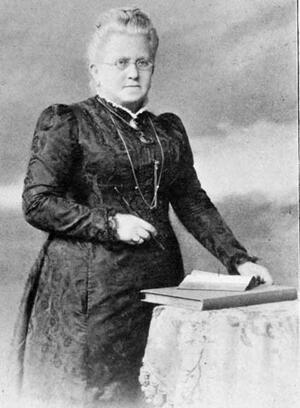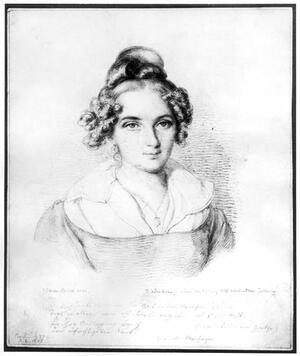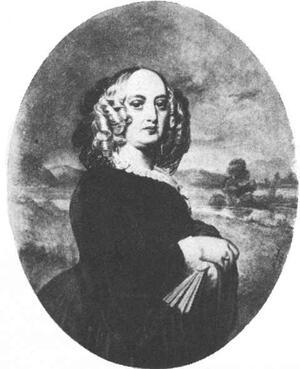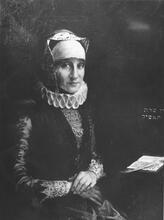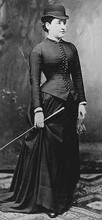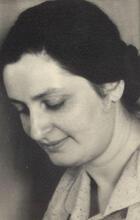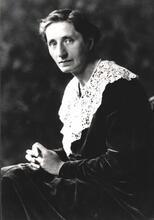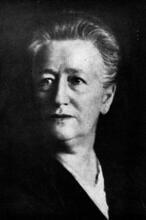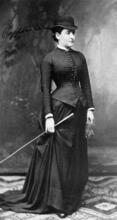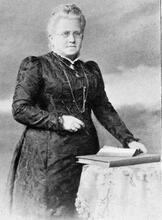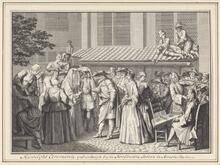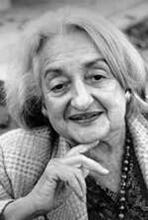Germany: 1750-1945
Legal restrictions on Jews decreased after Emperor Joseph II’s 1781 “Tolerance Decree.” As Enlightenment thought was taking hold, Jewish intellectuals, including a group of Jewish women, began engaging critically with Jewish tradition. Yet the Reform movement of the mid-nineteenth century failed to liberate women from their subordinate religious status, and the nineteenth-century bourgeois German family ideal with its rigid gender roles soon eclipsed the fluid structure of premodern Jewish families. As members of the middle-class, Jewish women were expected to transmit German bourgeois values while also shaping their children’s Jewish identity. In the first decade of the twentieth-century Jewish women began attending German universities and joined the feminist movement. After WWI, the social crisis experienced by German Jewish communities was understood through a gendered lens. National Socialism signaled the end of women’s equality and Jewish emancipation in Germany.
The Enlightenment
In the middle of the eighteenth century, Jews living in German territories were just beginning to feel the effects of the political, social and intellectual changes that would soon be recognized as the hallmarks of the modern world. Until this period, Jewish communities had been constituted as distinct and autonomous social, religious and legal entities within an essentially feudal social organization. The Jews were subjected to the will of the rulers of individual German states, who imposed onerous regulations, taxes and restrictions on their ability to marry and settle where they chose. Distinguished from the rest of the population by religious traditions and family structure, Jews lived under the authority of the Jewish community, wholly separate from the non-Jewish population. In the early 1780s, however, Enlightenment thinkers began to call for an end to the discrimination against Jews in Prussia and Austria. Most important among these voices was the high-ranking Prussian government official Christian Wilhelm Dohm (1751–1820), who argued that Jews be granted the same civil rights as those accorded to non-Jewish citizens. In his essay “On the Civil Betterment of the Jews” (1781) Dohm explained Jews’ moral “depravity” as the result of centuries of oppression. Only with the elimination of the oppressive conditions that produced their allegedly defective character, Dohm argued, would Jews be able to gradually overcome their “disabilities” and prove themselves to be useful citizens.
These changes in the intellectual realm coincided with broader social and political realignments of the period. In its attempt to centralize its power and eliminate intermediate corporate bodies such as guilds and estates, the emerging absolutist state also sought the dissolution of the autonomous Jewish community and the integration of its members into the larger social body. Thus the development of more modern social and political structures for German Jews arose as much from larger external factors as from a desire to address the particular situation of the Jews. Indeed, the practical reforms that were introduced by Emperor Joseph II in his “Tolerance Decree” of 1781 probably exerted a more immediate impact on the situation of Jews in parts of the German-speaking territories than did Enlightenment thought itself. Joseph II’s decree enacted the first legal measures to reduce legal restrictions on the Jewish population in parts of the Habsburg Empire. Despite the beginnings of a more consolidated state authority, Jewish legal status still varied within the territories of the German Empire until the unification of Germany in 1871.
Impact of Emancipation
Along with the political developments which gradually began to erode the legal barriers separating Jews from non-Jews were important changes that took place within Jewish society itself. Influenced by the spirit of the Enlightenment, Jewish intellectuals began a new critical engagement with Jewish tradition and, in so doing, created a new cultural, social and intellectual framework and helped bring forth an invigorated public sphere that challenged the authority of the official Jewish community. A new intellectual elite emerged, distinct from the rabbinate and its influence. The combined impact of the centralizing absolutist state and the emergence of the European and Jewish Enlightenments marked the beginning of a change in the legal status of the Jews that would extend over more than a hundred-year period. Yet the progress of Jewish Emancipation in different territories was anything but linear. During periods of political liberalization, progress toward equal rights proceeded apace, but the process was set back during periods of conservative counterreaction.
Because of the protracted nature of the struggle for Jewish Emancipation, and the twin efforts to win both legal and social acceptance, the uneven development of Emancipation was a central defining experience for German Jews. Yet historians have generally treated the Emancipation of the Jews as an event of universal significance for German Jewry without paying significant attention to the gendered aspects of its unfolding. After a long and often painful process, Jewish men did finally achieve full political and civil rights with the unification of Germany in 1871. In principle, if not entirely in practice, this removed most remaining legal disabilities that had prevented the full integration of male Jews into German society. But at the time of Emancipation, Jewish women—like women in general—received no such rights and remained unable to vote until 1918. In fact, as men looked toward an era of increasing liberalization, women were politically disenfranchised as the result of a law that was in effect until 1908, banning women from joining political organizations. Although German women were citizens, their status was ultimately determined by the citizenship of their father or husband. The status of East European Jewish women was even more precarious, since many immigrant women were not permitted to become citizens at all. Within the Jewish community, Jewish women had to wait even longer to gain a voice and a vote. In Germany, Jewish women suffered the double indignity of sexism and antisemitism, with second-class status imposed both inside and outside the Jewish community.
If Emancipation affected Jewish men and women in distinct ways, the pace and extent to which Jews adapted themselves to the demands of German society also differed according to gender-specific patterns. Because social acceptance was made contingent upon the acquisition of the basic customs, behaviors and values of German society, Jewish men and women took different paths toward, and found different means for, becoming at once fully German and distinctly Jewish. Jewish men tended to adapt to the demands of middle-class society by abandoning public religious behaviors, including the observance of Jewish dietary laws and the prohibition of work on the Sabbath. They also concerned themselves less with Jewish learning and worship than with secular education, which they pursued with unparalleled enthusiasm. For women, the road to acculturation led to the formation of new roles inside and outside the home. Changes in family structure and employment patterns led to adjustments in the gender division of labor between the domestic and public spheres, and these changes in the family, religion and labor, in turn, affected the construction of gender roles within the Jewish community, and gender relations as a whole. Even the category “Jewish woman” was infused with new meanings that accorded with middle-class norms and ideals for the bourgeois German woman. In fulfilling their newly defined “woman’s nature,” Jewish women created a proliferation of voluntary associations, involved themselves in non-Jewish associations, and pioneered the field of social work. The path to becoming “German” and “German Jewish” thus proved to be profoundly gendered.
Intellectual Upper-Class Jewish Women
One of the earliest examples of a specifically female experience of the Enlightenment can be found in the Berlin salons of the late eighteenth century. Although the German Jewish Enlightenment is usually associated with the intellectual circle around Moses Mendelssohn and its literary output, most historical literature has treated the Enlightenment as an intellectual and socio-cultural phenomenon that has almost exclusively involved men. Yet during the last two decades of the eighteenth century, even as Mendelssohn was evolving his philosophical reformulation of Judaism, a small group of young women from Berlin’s small but influential Jewish upper class crafted a place for themselves at the very center of the city’s social and intellectual life. Jewish salionières, most notably Rachel Levin Varnhagen and Dorothea Schlegel Mendelssohn, hosted social and intellectual gatherings in their homes that brought together Jews and non-Jews, noblemen and commoners to socialize and exchange ideas. Creating a cultural space unprecedented in its openness to Jews and women, these salons appear to have existed only for a brief historical moment as if outside the normal social constraints that enforced the hierarchical organization of society around the axes of gender, class and religion.
Because a substantial number of these women converted to Christianity and entered into (often second) marriages with non-Jews, Jewish historians have sometimes been quick to condemn them for the betrayal of their people and faith. So traitorous were they, concluded Heinrich Graetz, that “these talented but sinful Jewish women did Judaism a service by becoming Christians” (Lowenstein, 109). Indeed, for their contemporaries, as well as for many historians, these women represented the embodiment of a larger set of social problems afflicting Berlin Jewish society. Whatever the exact mix of their motives for conversion and intermarriage—an ascent in social status, the promise of companionate marriage or liberation from their patriarchal families—the fact that contemporary observers and later historians held these boundary-crossing women responsible for the most visible symptoms of modern social change suggests the extent to which the transition from traditional Jewish society to modern Judaism was represented through the language of gender.
Women & The Reform Movement
Among the earliest and most important trajectories for the progress of German Jewish acculturation was the modernization of Judaism. Although religious modernization by no means did away with gender hierarchy, it nevertheless altered gender expectations and gender roles, as well as popular forms of religious practice. Within traditional Judaism, those aspects of religious practice that had historically been invested with the greatest value were organized hierarchically along clearly gendered lines: the study of Torah she-bi-khetav: Lit. "the written Torah." The Bible; the Pentateuch; Tanakh (the Pentateuch, Prophets and Hagiographia)Torah and public prayer formed the religious centerpiece of Jewish life, and these acts were accessible only to men. Women’s religious activity tended to be less structured and more personal and took place primarily in the family, focusing on religious aspects of home life, the observance of Sabbath and holidays, and the maintenance of dietary and family purity laws. Though accorded importance within Judaism, these “domestic” practices of Judaism were lower in prestige than the more public practice of Judaism dominated by men.
The liberal religious reform movement, which has garnered so much attention in the historical literature, did not, however, fundamentally transform the role of women in Judaism. Reformers seeking to modernize Judaism in accordance with Enlightenment ideals and middle-class behavioral and aesthetic visions endeavored to make prayer services more attractive to women as well as men by changing the language of prayer from Hebrew to German and replacing Hebrew excurses on the law with uplifting preaching in German that was modeled on Protestant worship services. Equally important, greater attention was paid to women’s religious education, primarily through the inclusion of women in the newly introduced ritual of confirmation. There was even some discussion at the 1846 Rabbinic Assembly in Breslau of far-reaching changes that would have granted women greater religious equality. Yet when it came to practice, the nineteenth-century Reform movement failed to eliminate many of the traditional religious restrictions that kept women in a subordinate status. In the synagogue, women could still neither be counted in a prayer quorum nor called to the Torah, and they often remained seated apart and comfortably out of view in the women’s gallery. Despite pronouncements against the segregation of women, religious reformers ultimately made few substantial improvements in women’s status.
Rise of the German Jewish Middle-Class
In addition to religious reform, religious modernization also includes those religious and cultural changes that resulted from the increased participation of women in religious associations outside the home and the formal sphere of the Jewish community. Indeed, it may well have been this phenomenon, more than religious reform itself, which affected gender relations more broadly and contributed to a more substantive reconfiguration of the traditional Jewish gender order. Beginning in the late eighteenth century, middle-class women began to create charitable associations, such as sick care and self-help societies, that mirrored both the form and content of male associations. According to the historian Maria Benjamin Baader, these new female voluntary organizations were made possible with the declining emphasis on traditional male learning that had once marked women as marginal. Expressing both Jewish and bourgeois values, women’s activity in this realm would, by the early twentieth century, lead into new professional opportunities as well as to the production of new forms of Jewish religious and ethnic expression.
Women’s activities in voluntary organizations, in turn, were linked to broader cultural shifts in the German bourgeoisie. Thus, in addition to being inflected by gender, it is important to note that the process of becoming a German Jewish woman was also affected by class status. Whereas on the eve of the modern era the majority of German Jews were poor, as they entered German society over the course of the nineteenth century, Jews aspired to join the class that was most suited to their skills in trade and commerce: the middle-class. Jews quickly embraced the ideal of the educated middle class that made culture, rather than birth, the defining character of class. While middle-class status for men was to be achieved through self-improvement and education (Bildung), the most important determinant of middle-class respectability for women and for their husbands was her status as full-time “priestess of the home.”
Paradoxically, an important measure of specifically Jewish and middle-class acculturation was a new form of family-centered Judaism that arose out of the strong emphasis placed on the family in bourgeois culture on the one hand, and the decline in traditional Jewish religious practice on the other. The nineteenth-century bourgeois ideal for the family was a prescriptive model based on a rigid gender-based division of labor that delimited women’s activities to the domestic sphere and men’s activity to the “public” arena. As an ideal, it quickly eclipsed the typical structure of premodern Jewish families where the boundaries between public and private remained more fluid. Of course, not all Jewish families could afford to imitate this model, since lower middle-class and working-class families often had to rely on the work and wages of children and wives for the family economy. But the power of this construct as a universal model for Jewish family life is perhaps most evidenced by the fact that, since the mid-nineteenth century, the bourgeois family type has been viewed as the “traditional Jewish family.”
The Home: Acculturation and Transmission of Judaism
By the time the German states were joined in a federal system within the new German Empire in 1871, most of Germany’s Jews could proudly display their middle-class status by pointing to their family life. Indeed, the research of Marion Kaplan has demonstrated how Jewish women managed the double task of transmitting the values and behaviors of the German bourgeoisie while helping to shape the Jewish identity of their children. Jewish women made sure their children learned the German classics and, at the same time, organized the observance of holidays, family gatherings and the religious and moral education of the children. Illustrating the family’s crucial role in the acculturation of German Jews, Kaplan’s research also suggests the extent to which the home was gradually being recast as the primary site for the transmission of Judaism. With the declining appeal of formal religious practice and institutions, including the synagogue, the Jewish mother, according to historian Jacob Toury, was expected to become the “protector of a new system of Jewish domestic culture” (Maurer, 147).
Although some historians suggest that Jewish men abandoned religious ritual and practice more quickly than women, by mid-century Jewish community leaders nevertheless began holding women increasingly accountable for assimilation, conversion and intermarriage—in short, for the decline of Judaism. This was the case despite the fact that the intermarriage and conversion rates of Jewish women remained lower than those of men through almost the entire nineteenth century. Even in the early twentieth century, twenty-two percent of Jewish men but only thirteen percent of Jewish women entered marriages with non-Jews. Whereas Jewish men who entered mixed marriages usually had middle-class incomes, Jewish women, by contrast, tended to marry non-Jews out of economic need or because of a lack of available male Jewish partners. And even though women’s intermarriage rates were lower than men’s, women in mixed marriages stood to lose their status in the official Jewish community, while men suffered no equivalent punishment. Male and female conversion rates similarly reflected the disproportionately high male intermarriage rates. Relatively few women converted before 1880, and when the rate increased, as it did during the years 1873–1906, women still accounted for only one quarter of all converts. In comparison with male converts, nearly double the number of women came from the lowest income categories. Rising female conversion rates appear to have coincided with the growth of secularization on the one hand, and women’s increasing participation in the workforce and ensuing encounter with antisemitism on the other. By 1912, women accounted for forty percent of all conversions.
Childhood, Adolescence and Early Adulthood
Throughout the nineteenth and early twentieth centuries, Jewish girls received an education that was consonant with social expectations for women of their class. Until the 1890s, the only form of secular education available to girls was the elementary school and non-college-preparatory secondary school. Jewish girls of all classes attended either private or public elementary schools where they learned reading, writing, arithmetic and such “feminine” subjects as art, music and literature. From mid-century on, a disproportionately high percentage of Jewish girls attended girls’ secondary schools (Höhere Töchterschule) which tended to be associated with upward mobility and higher class status. Indeed, around the turn of the century, while 3.7 percent of non-Jewish girls in Prussia attended the Höhere Töchterschule, approximately forty-two percent of Jewish girls did. Upon completing school at the age of fifteen or sixteen, middle-class girls passed their time socializing, embroidering or doing volunteer work as they waited for their families to find them a suitable husband.
Even through the Imperial period, most middle-class Jewish marriages continued to be arranged either by marriage brokers or, more often, with the aid of parents and relatives. As a social institution, arranged marriage served as a means of locating Jewish marriage partners while simultaneously providing for the financial security of middle-class daughters and cementing economic alliances between families. By the end of the nineteenth century, the heavy emphasis placed on financial considerations in the search for marriage partners generated substantial criticism from within the Jewish community and particularly among young modern-minded women who wanted to choose their own life partners on the basis of romantic love. Beginning with the salon women in the eighteenth century, the decision to marry a non-Jewish man appears to have sometimes been driven at least in part by the ideal of companionate marriage. In other words, for some women, intermarriage represented not simply an act of betrayal, as it was sometimes perceived by observers, but in fact an act of independence, a rejection of a patriarchal social system that treated marriage as a financial and social transaction that was divorced from the individuals themselves.
Higher Education & Employment
Since the nineteenth-century ideology of separate spheres consigned women to the home, those women who desired access to higher education and professional training had a particularly difficult path to navigate. For both men and women, higher education offered a means of self-improvement that facilitated German Jewish acculturation together with the possibility for personal emancipation. Yet whereas young Jewish men had been permitted to attend college preparatory high schools (gymnasia) and universities since the early nineteenth century, Jewish women had been excluded from both institutions until the end of the century. It was not until the first decade of the twentieth that German universities began admitting women. In the three years following the opening of Prussian universities to women in 1908, Jewish women already accounted for eleven percent of the female student population. By the time of the Nazi accession to power in 1933, a high proportion of Jewish women received doctorates from German universities. One of the fields of study most in demand among Jewish women, and east European Jewish women in particular, was medicine. Philosophy was also the first choice of many Jewish women since it provided the required academic preparation for a teaching certificate. As one of the few careers considered socially acceptable for middle-class women, education continued to draw Jewish women despite the antisemitic discrimination they often faced. With somewhat less frequency, Jewish women also studied the social and natural sciences and law. Despite the relative prevalence of Jewish women at universities, however, their social acceptance did not proceed apace. Like men, Jewish women encountered widespread antisemitism at the university, but their sex proved to be an added obstacle in their path toward integration.
Because of the predominantly middle-class status of German Jews, fewer Jewish women were wage earners than non-Jewish women. But both single and married Jewish women did work outside the home, and they did so in growing numbers. The 1882 employment statistics for Prussia list only eleven percent of all Jewish women as part of the labor force, compared with twenty-one percent of non-Jewish women, but this figure masks the work of many more women who helped run family businesses or otherwise contributed to the household economy. In 1907, when the Prussian census included more of these invisible female workers, the employment rate was eighteen percent of Jewish women, compared with thirty percent of non-Jewish women. By the time of the Weimar Republic, with increased east European immigration, a worsening economy, and an increasing number of women working to support themselves, the gap between the Jewish and non-Jewish employment rate narrowed further, with twenty-seven percent of Jewish women now working, compared with thirty-four percent in the general population. Like Jewish men, middle-class Jewish women worked disproportionately within the commercial sector of the economy. But in contrast with native-born German women, east European immigrant working women were clustered in industrial labor, primarily in the tobacco and garment industries. In specifically low-status female occupations such as domestic service, east European immigrant women were significantly overrepresented.
One of the promising new employment opportunities for Jewish and non-Jewish women at the turn of the century was social work. Formulated by women themselves as an extension of the domestic sphere, social work involved, in the words of Alice Salomon, one of the Jewish founders of modern social work in Germany, “an assumption of duties for a wider circle than are usually performed by the mother in the home” (Taylor Allen, 213–214). Jewish women seemed to flock to the profession, evident in their overrepresentation within social work training colleges. Particularly during the Weimar Republic, social work stood out as a field generally free from the mounting antisemitism increasingly being felt in other professions. Among those Jewish women who trained as social workers, some elected to work with the working class, lower middle class and east European Jewish population sectors within the Jewish community that required, in the view of their middle-class patrons, the provision of health services, job training and “moral reform.” From their roles as organizers of mutual assistance and charitable work in the eighteenth century, middle-class Jewish women became, by the Weimar period, the agents of a rationalized and “scientific” social work, one that was viewed by its practitioners as the modern-day realization of the traditional Jewish ethic of charity. As a gendered sphere of Jewish communal activity, the social arena became not only a site where those in need received assistance, but also a form of Jewish social engagement that strengthened the bonds of solidarity and cohesion among those engaged in social work.
The Feminist Movement
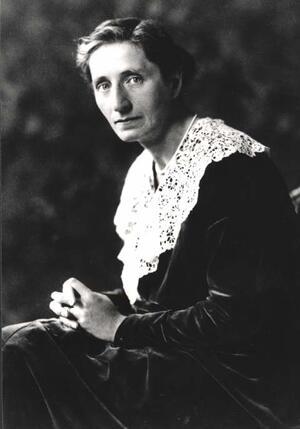
Though baptized a Protestant as a young woman, social worker Alice Salomon shut down her innovative Women's Academy in Berlin rather than oust Jewish faculty and students as the Nazis demanded. She is shown here in 1920.
Courtesy of Professor Joachim Wieler, Germany
Institution: The Alice Salomon Archive, Berlin
In Germany, this idea of “social motherhood” not only provided the intellectual foundation and political justification for the emergence of modern social work, but it also animated the German feminist movement from its early years until its collapse and cooptation under Hitler in 1933. Feminists’ conceptions of citizenship, rooted in distinctly organic notions of German citizenship, emphasized duties over rights and tended to define individual self-fulfillment in the context of community. Social motherhood also formed a central pillar of the German Jewish feminist movement that was founded by Bertha Pappenheim in 1904. The membership of the Jüdischer Frauenbund, which consisted primarily of middle-class married women, engaged in social work, provided career training for Jewish women, sought to combat White Slavery and fought for the equal participation of women in the Jewish community. Claiming the membership of more than twenty percent of German Jewish women, the Frauenbund became an increasingly important organization on the German Jewish scene until its dissolution by the Nazis in 1938.
Middle-class Jewish women who were less interested in joining their Jewish and feminist commitments could become active in the moderate wing of the German Women’s movement, whereas working-class and east European women tended to join unions or the socialist women’s movement. Within the bourgeois women’s movement, Jewish women assumed significant leadership roles: Fanny Lewald and Jenny Hirsch gave voice to the aspirations of the movement through their writings on the “Woman Question,” while Jeanette Schwerin (1852–1899), Lina Morgenstern, Alice Salomon and Henriette Fürth became important women’s rights leaders and social workers. It has been estimated that approximately one third of the leading German women’s rights activists were of Jewish ancestry.
Social Crisis Following WWI
The new democratic republic that was born amidst the catastrophe of German defeat in World War I promised Germans their first real possibility for liberal democratic governance. The constitution guaranteed equal rights to all its citizens, including full and complete equality for Jews and women. But the spirit of openness and tolerance enshrined in the constitution was quickly compromised by an eruption of virulent antisemitism that resulted in a growing economic and social exclusion of Jews, even as opportunities in some fields, such as politics and the professions, continued to expand. Weimar’s contradictory bequest to Jews—greater inclusion but also growing exclusion and intensified antisemitic rhetoric—was fueled by the ongoing economic and political instability of the period.
In addition to the political instability that dogged the Republic from its inception, social and economic changes ushered in by the war also led to shifting gender roles. Many more women entered the workforce out of economic necessity and young women also sought out new professional opportunities. These and other changes in turn gave rise to the widespread perception that Germany—and German Jewry—faced an unprecedented social crisis. Rising rates of juvenile delinquency and out-of-wedlock births, the decline in the number of marriages and numbers of children born, suggested to many middle-class observers that the Jewish family could neither socially nor biologically reproduce itself. Nothing embodied the social threat posed by young women to the Jewish middle-class gender norms better than the image of the sexually liberated and financially independent “New Woman,” who reputedly rejected motherhood in favor of a hedonistic urban lifestyle. What is particularly significant in the 1920s is how the identification of social crisis, as in Berlin over one hundred years before, was conceptualized largely through the lens of gender.
Offering a counterpoint to the emancipated Jewish New Woman, male and female Jewish leaders placed new emphasis on the reproductive Jewish woman. Feminist leaders joined rabbis and eugenicists in calling for an increased Jewish birthrate and Jewish women’s organizations dedicated themselves to reversing Jewish women’s “self-imposed infertility” (von Ankum, 29). By reproducing Jews, women would be helping to fortify a declining Jewish community and fighting the rising tide of assimilation. In an age of assimilation, Jewish mothers had a vital role to play in the maintenance of Jewish difference itself.
In the construction of a redemptive Jewish femininity that would address the challenges of assimilation, Jewish women also sought to redefine the meaning of Jewish motherhood at a time when national identity among non-Jewish Germans was growing increasingly exclusionary. According to both male and female leaders at the time, a crucial part of a Jewish mother’s task in the 1920s was to educate her children in ways that would help reduce antisemitism, while simultaneously making her family a refuge from antisemitic hostility. Shaping a new form of Jewishness that could both resist the appeal of Gentile acceptance and minimize Gentile hatred became an important aspect of Jewish “women’s work” in the 1920s. Women were thus cast both as the problem and the solution, embodying both the threat of a barren future and the promise of collective renewal.
The Impact of National Socialism
With the slide of the Weimar Republic into authoritarianism and ultimately dictatorship in the early 1930s, National Socialism signaled the end of democracy, women’s equality and Jewish emancipation in Germany. Although National Socialism targeted Jewish men and women equally, the impact of restrictive regulations, increased antisemitism and social exclusion affected Jewish men and women in ways that were often distinct. Marion Kaplan’s research on the 1930s shows how social exclusion experienced by men in the workplace appears to have had somewhat of a lesser impact than the increasing isolation from the informal social networks maintained by women. In addition, women often proved to be more attuned to the humiliations and suffering of their children. Perhaps less invested in their professional identities than their husbands, women were more willing to risk uncertainty abroad. Overall, women displayed greater adaptability than men in reorienting their expectations and their means of livelihood to accommodate new realities both at home and abroad. Ironically, it may have been women’s very subordinate status that made them more amenable to finding work that under other circumstances would have been considered beneath them.
Gender roles in Jewish families also shifted as families faced new and extreme economic and social realities. Women increasingly represented or defended their husbands and other male relatives with the authorities. In addition, many more women worked outside the home than before the Nazi period and became involved in Jewish self-help organizations that had been established after Hitler’s rise to power. Some had never worked before, while others retrained for work in Germany or abroad. Although women often wanted to leave Germany before their husbands came to share their view, they actually emigrated less frequently than men. Parents sent sons away to foreign countries more frequently than daughters, and it was women, more than men, who remained behind as the sole caretakers for elderly parents. Indeed, a large proportion of the elderly population that remained in Germany was made up of women. In 1939, there were 6,674 widowed men and 28,347 widowed women in the expanded Reich.
Although men and women were equally targeted for persecution and death, they were subjected to different humiliations, regulations and work requirements. Within certain types of mixed marriages, Jewish men faced greater dangers than women. In the case of childless intermarriages consisting of a Jewish woman and an “Aryan” man, the female Jewish partner was not subjected to the same anti-Jewish laws as the rest of the Jewish population. But a Jewish man with a female “Aryan” wife in such a marriage received no special privileges. With the onset of the war, German Jewish women began to suffer the kind of physical brutality that many of their husbands, fathers and brothers had endured during the 1930s. Overall, however, Jewish men were probably more vulnerable to physical attack than women. Although Jewish women who went into hiding could move about more freely and were in less danger of being discovered than men, it is speculated that fewer women than men actually went into hiding. Despite their equal status as subhuman in the eyes of the Nazis, Jewish men and women frequently labored to survive under different constraints. As was the case in other countries outside of Germany, Jewish women appear to have suffered the ultimate fate of death in disproportionately greater numbers.
Even for an historical event as defining as the Holocaust, gender analysis proves a valuable means for elucidating different reactions to persecution by men and women, as well as highlighting gender-distinctive experiences of emigration, hiding and surviving in the camps. To view German Jewish history from the Enlightenment through the Holocaust from a gender perspective deepens our understanding of history in general and provides us with a richer, more complex and more inclusive picture of the Jewish past.
Allen, Ann Taylor. Feminism and Motherhood in Germany 1890–1914. New Brunswick, NJ: Rutgers University Press, 1991.
Ankum, Katharina von. “Between Maternity and Modernity: Jewish Femininity and the German-Jewish ‘Symbiosis.’” Shofar 17, no. 4 (Summer 1999): 20–33.
Baader, Benjamin Maria. Gender, Judaism, and Bourgeois Culture in Germany, 1800-1870 (The Modern Jewish Experience). Bloomington, IN: Indiana University Press, 2006.
Fassmann, Irmgard Maya. Jüdinnen in der deutschen Frauenbewegung 1865–1919. Hildesheim: Olms, 1996.
Freidenreich, Harriet. Female, Jewish and Educated: The Lives of Central European University Women. Bloomington, IN: Indiana University Press, 2002.
Hertz, Deborah. High Society in Old Regime Berlin. New Haven, CT: Yale University Press, 1988.
Hyman, Paula. Gender and Assimilation in Modern Jewish History: the Role and Representation of Women. Seattle, WA: University of Washington Press, 1992
Kaplan, Marion. Between Dignity and Despair: Jewish Life in Nazi Germany. New York: Oxford University Press, 1998.
Kaplan, Marion. The Jewish Feminist Movement in Germany: The Campaigns of the Jüdischer Frauenbund, 1904–1938. Westport, CT: Greenwood, 1979.
Kaplan, Marion. The Making of the Jewish Middle Class: Women, Family, and Identity in Imperial Germany. New York: Oxford University Press, 1991.
Kaplan, Marion. Jewish Daily Life In Germany, 1618-1945. New York: Oxford University Press, 2005.
Lowenstein, Steve. Berlin Jewish Community: Enlightenment, Family, Crisis 1770–1830. New York: Oxford University Press, 1994
Maurer, Trude. Die Entwicklung der jüdische Minderheit in Deutschland (1780–1933). Berlin: De Gruyter, 1992.
Meyer, Michael, and Michael Brenner. German-Jewish History in Modern Times, Vols 1–4. New York: Columbia University Press, 1997.
Quack, Sybille. Between Sorrow and Strength: Women Refugees of the Nazi Period. Cambridge: Cambridge University Press, 1995
Rahden, Till van. “Intermarriages, the ‘New Woman’ and the Situational Ethnicity of Breslau Jews from the 1870s to the 1920s.” Leo Baeck Institute Yearbook 46 (2001) 125–150.
Richarz, Monika. “Jewish Social Mobility in Germany during the Time of Emancipation (1790–1871).” Leo Baeck Institute Yearbook 20 (1975): 69–77.
Springorum, Stefanie Schüler. “Deutsch-Jüdische Geschichte als Geschlechtergeschichte.” Transversal: Zeitschrift des David-Herzog-Centrums für jüdische Studien 1 (2003): 3–15.
Usborne, Cornelie. “The New Woman and Generational Conflict: Perceptions of Young Women’s Sexual Mores in the Weimar Republic.” In Generations in Conflict: Youth Revolt and Generation Formation in Germany, 1779–1968, edited by Mark Roseman, 137–163. Cambridge: Cambridge University Press, 1995.
Volkov, Shulamit. Die Juden in Deutschland 1780–1918. Munich: R. Oldenbourg Verlag, 1994.
Volkov, Shulamit. “Jüdische Assimilation und Eigenart im Kaiserreich.” In Jüdisches Leben und Antisemitismus im 19. und 20. Jahrhundert, edited by Shulamit Volkov, 131-145. Munich: C.H. Beck, 1990.
Werthheimer, Jack. Unwelcome Strangers. New York: Oxford University Press, 1987.
Zimmermann, Moshe. Die deutschen Juden, 1918–1945. Munich: De Gruyter, f1997.

